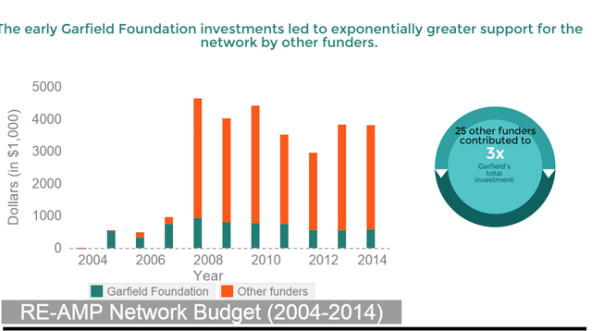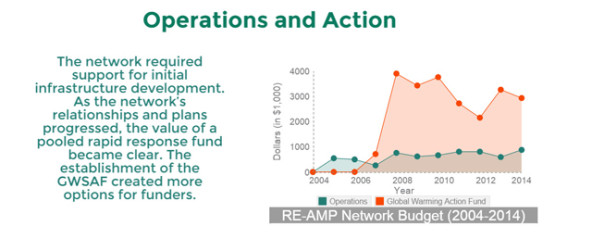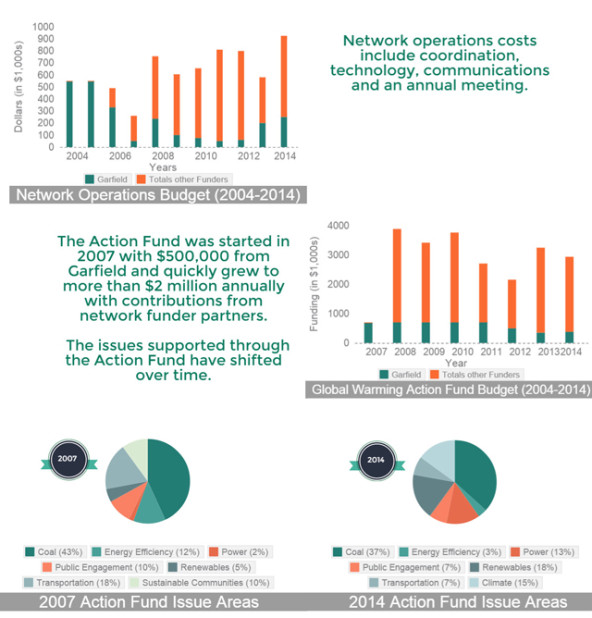While still an emergent grantmaking strategy, more foundations are investing in network building as an effective tool for achieving their goals and leveraging their dollars. Even so, network investing is not for the faint of heart. Foundations must consider the scope of resources required to initiate a network approach, and support the infrastructure and collaborative projects needed to produce results. Yet we see cases where foundations with modest corpuses have leveraged their charitable dollars many times over by engaging other funders as network partners, significantly increasing the pool of funding for a change initiative over time.
The team at Network Impact is interested in understanding the resource benefits and other kinds of value created through a network approach to network funding. To that end, the Garfield Foundation—a mid-sized philanthropy—kindly offered to share financial data related to its 10-plus year investment in RE-AMP.
RE-AMP is a network of more than 160 nonprofits and foundations across eight Midwest states working on climate change. The network’s launch in 2004 followed a year-long systems analysis process in which several foundations and nonprofit environmental and clean energy advocates met to explore how they might work together to expand the region’s use of clean and renewable energy. The Garfield Foundation covered nearly all of the expenses in the early phase of RE-AMP’s development, including costs associated with the initial systems analysis and a network design process that followed. In addition, and from the outset, the Garfield Foundation committed $500,000 of grant funding annually for five years if the strategies that emerged were informed by the systems analysis and generated collaboration among network members.
It took only one year before other foundation participants recognized the potential of the approach, and began to realign their grantmaking and contribute to the cost of network operations. In 2007, funder-members created the Global Warming Strategic Action Fund (GWSAF)—a re-granting pool that supports just-in-time innovative actions at the state level. The RE-AMP Network also developed, and now sustains, a shared set of resources, including: an online collaboration platform; a system to support shared learning; in-person working group meetings; media and communications capacity that develops shared framing; capacity building to strengthen campaign design, planning, and execution; and an annual gathering of the membership.
Leveraged Dollars
Piktochart)"> Funder investments in RE-AMP Network. (All graphs created by Network Impact using Piktochart)
Funder investments in RE-AMP Network. (All graphs created by Network Impact using Piktochart)
Are you enjoying this article? Read more like this, plus SSIR's full archive of content, when you subscribe.
Our review of RE-AMP financial data confirmed that, in the first 10 years that the network was active (2004-2013), the Garfield Foundation invested a total of $8.8 million. During these same years, another 25 foundations contributed to RE- AMP operations and projects, increasing overall support for the network and its projects to more than $24 million. Within a few years of its creation, annual contributions to RE-AMP from other grantmakers exceeded the Garfield Foundations’ investment by at least 50 percent. By 2007, other funders were covering 75 percent of RE-AMP’s total budget, reflecting an increasingly broad base of support.
Strategic and Flexible
RE-AMP funders, as a group, target their investments in response to information about emerging regional opportunities and challenges that they are privy to through the “collective intelligence” of the RE-AMP network. Grantmakers also continue to target their investments in line with their individual priorities and charter.
 RE-AMP Network operations and action fund breakdown.
RE-AMP Network operations and action fund breakdown.
 Garfield investments compared to other RE-AMP funders for operations and action fund.
Garfield investments compared to other RE-AMP funders for operations and action fund.
The graphic above describes the contributions of RE-AMP funders to network operations and infrastructure, the GWSAF, and the percent of pooled funds going to different issues in 2007 (the first year of the GWSAF) and 2014. Operations funding mainly takes the form of grants to member organizations that execute RE-AMP activities. It is also important to note that the total investment motivated by the work of RE-AMP members is larger. These figures do not include funds that go directly from foundations to grantees that are members of RE-AMP. Numbers here also do not take into account the value of aligned grants for advocates’ projects that are stimulated as a result of funder co-learning and access to information from the field that network partners generate.
Network Advantage
RE-AMP has an impressive track record. In a little over a decade, RE-AMP members have contributed to the retirement of more than 150 coal plants and prevented the planning of any new, non-carbon neutral plants in eight Midwestern states. Network accomplishments also include state, regional, and local adoptions of energy efficiency resource standards; the creation of financing programs for energy-efficient improvements and renewable energy standards implementation; and public transportation legislation. These advancements in the Midwest have helped make it possible for the EPA to propose the Clean Power Plan, which aims to reduce national power plant emissions 30 percent below 2005 levels by 2030.
These and other successes reflect the actions of RE-AMP members, including funders, who understand the value of network approaches for developing, financing, and scaling solutions to complex social problems. Participation in a network allows foundations to leverage their individual investment by surfacing multiple, ongoing opportunities for collaborative grantmaking. As the Garfield Foundation’s experience with RE-AMP demonstrates, organizing in this way also allows network funders to co-create and co-evolve effective strategic actions while leveraging charitable dollars for greater impact.
Support SSIR’s coverage of cross-sector solutions to global challenges.
Help us further the reach of innovative ideas. Donate today.
Read more stories by Madeleine Taylor.

